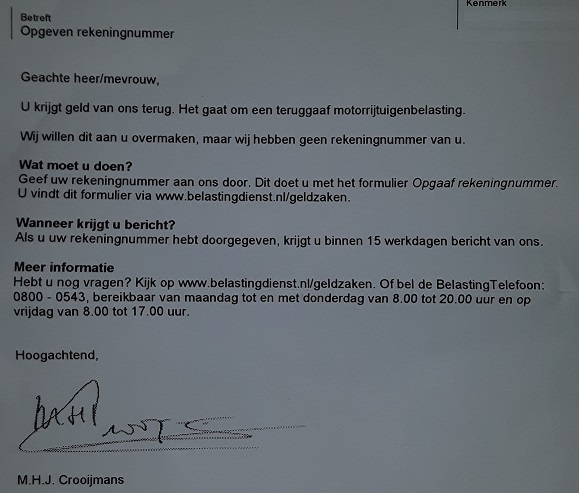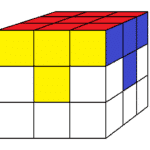 To begin solving Rubik’s Cube, first choose the face (color) you want to solve first. In these posts, I’ve picked Red. This face will be the top layer. First to solve are the four edge blocks of this layer; next are the vertex (corner) blocks.
To begin solving Rubik’s Cube, first choose the face (color) you want to solve first. In these posts, I’ve picked Red. This face will be the top layer. First to solve are the four edge blocks of this layer; next are the vertex (corner) blocks.
Step 1 – Edges
Orient the Cube so that the chosen face (red) is facing up.
Bring the edges of the chosen face to their locations and orient them correctly. This is the very first step, and this early in the process, it does not matter at all what happens to all the other blocks in the cube. This should be an entirely trivial step, which does not need step-by-step instructions.
Ensure that the four edge blocks end up in their places, with the face color you chose facing up, and the other colors of the edge blocks align with the middle tiles of the other faces.
Step 2 – Vertices
The vertices, or corner blocks, can be moved into their locations and turned to their correct orientations one by one, with only a single series of turns needed for each vertex.
- Choose the vertex you want to solve in the top layer.
- Orient the cube so that the vertex you want to solve is top-front-and-right.
- Find the corresponding vertex block.
- If the vertex block happens to be already in the top layer, but turned so that the colors don’t align, or if it’s in the wrong vertex location, you can use either sequences 7 or 8 to get it out of its place, and then proceed.
- Rotate the bottom layer so that the vertex block is directly below its location (down-front-right).
- Check where the top layer color (red in this example) is on the vertex block: facing towards you, facing right, or facing down.
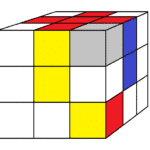 If it’s facing right, twist this sequence:
If it’s facing right, twist this sequence:
R- D- R+
This moves the vertex block to its proper location, oriented correctly.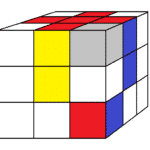 If it’s facing towards you, twist this sequence:
If it’s facing towards you, twist this sequence:
F+ D+ F-
(This is the same sequence, but mirrored on the vertical edge that the vertex is on.) If it’s facing down, twist either F+ D2 F- D- or R- D2 R+ D+ to turn it. After that, it’s oriented facing either front or right, and you can solve it as described ins steps 7 and 8.
If it’s facing down, twist either F+ D2 F- D- or R- D2 R+ D+ to turn it. After that, it’s oriented facing either front or right, and you can solve it as described ins steps 7 and 8.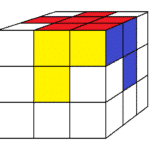 The vertex block should now be in its location, and oriented correctly, so that its three colors align with the three faces it sits on (colors matching the middle tiles of these three faces).
The vertex block should now be in its location, and oriented correctly, so that its three colors align with the three faces it sits on (colors matching the middle tiles of these three faces). Repeat these step for all vertices in the top layer. The end result should be that the entire top layer is a single color (red in the example), and the colors of its edges align with the middle tiles on all sides.
Repeat these step for all vertices in the top layer. The end result should be that the entire top layer is a single color (red in the example), and the colors of its edges align with the middle tiles on all sides.
Next step is solving the middle layer, specifically the four edge blocks below the layer you’ve just solved.

